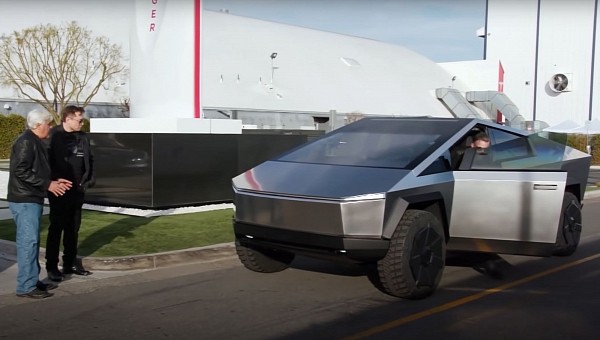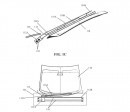Back in 2014 all of Tesla’s patents went open source. At the time, the company said it did so “for the greater good of electric vehicle development.” Today, the stakes are high, and the competition is fierce. Legacy automakers and newcomers are not backing down. So, the famous EV maker decided to protect its findings by patenting them. Here are the latest ones.
Elon Musk said that patents are “used like landmines in warfare.” He also doubled down by adding that these licenses for inventions “are for the weak.” The statements were made in September last year while Tesla’s executive was showing Jay Leno around SpaceX. Rather ironically, they were uttered after Tesla patented new energy-absorbing castings, global headlights design, a tire inflation system, and some quirky folding seats for the upcoming Cybertruck.
So, after all, patents are important for a company that’s trying to compete with other innovators. That could be why Tesla decided to even register an invention related to a windshield wiper. According to the United States Patent and Trademark Office (USPTO), the automaker applied for the legal protection of its invention almost two years ago. However, it was made available only recently, on the 3rd of January 2023, and given US 11541846 B2 as ID.
The EV maker argues that it is time for advancements in the field of windshield cleaning to deliver windshield wiper systems that “are not only visually appealing but are also effective in cleaning the windshields of a vehicle.” Also, Tesla says such a system is necessary because new cars need an unobstructed field-of-view, like those which come without ultrasonic sensors and rely only on a camera-based system to activate their advanced driver-assistance solutions.
The automaker’s idea is to simplify how windshield wipers work and to allow for a modular installation that eliminates the need for multiple mechanical components. For this to happen, a couple of things are needed first:
Depending on how Tesla will finalize this invention to be as cost-effective as possible, some or all the abovementioned parts will form an electromagnetic windshield wiper system. The company might also figure out other applications, like using “magnetic induction-based electrodynamic force to steer the wiper arm” to minimize friction, which is present in conventional systems.
Another patent filed in 2019 and disclosed at the beginning of 2023 reveals the automaker intends to build dry electrode films and microparticulate non-fibrillizable binders with certain particle sizes. While it sounds extremely complicated (and it is), this refers to a new way in which the electrodes found in batteries can be protected from additional degradation.
Simultaneously, this invention might also help with the structure of the battery packs because electrode film materials can be commingled through dry processing. Tesla also argues that redistributing the binders found on electrodes might lead to improved reliability of the battery packs.
Non-fibrillizable binders are polymers and co-polymers that aren’t capable of fibrillation, meaning they cannot be polarized and aligned as dipoles along the direction of the electric field.
“A dry or self-supporting electrode film incorporating such (small) microparticulate non-fibrillizable binder particles may provide improved characteristics relative to a typical electrode film,” explains Tesla in the US 11545666 B2 patent while also providing methods of fabrication for these materials.
If the company gets it right, then we might soon see a new generation of batteries that are capable of enduring a lot more road abuse without losing any of the initial range. That is, of course, within limits. Cells aren't yet capable of resisting longer periods of wear and tear.
Finally, the last disclosed patent filing refers to new electrode binders that can withstand higher operating voltages without going through a rapid degradation process which can cause a reduction in the battery pack’s performance or even a complete failure. This invention is essentially a coating that’s applied to the polymeric binder.
The three patents are available for a detailed consultation or download down below.
So, after all, patents are important for a company that’s trying to compete with other innovators. That could be why Tesla decided to even register an invention related to a windshield wiper. According to the United States Patent and Trademark Office (USPTO), the automaker applied for the legal protection of its invention almost two years ago. However, it was made available only recently, on the 3rd of January 2023, and given US 11541846 B2 as ID.
The EV maker argues that it is time for advancements in the field of windshield cleaning to deliver windshield wiper systems that “are not only visually appealing but are also effective in cleaning the windshields of a vehicle.” Also, Tesla says such a system is necessary because new cars need an unobstructed field-of-view, like those which come without ultrasonic sensors and rely only on a camera-based system to activate their advanced driver-assistance solutions.
The automaker’s idea is to simplify how windshield wipers work and to allow for a modular installation that eliminates the need for multiple mechanical components. For this to happen, a couple of things are needed first:
- a liner actuator with a guide rail and an electromagnetic moving block;
- a couple of permanent magnet bars disposed horizontally along the curvature of the windshield for the guide rail;
- an electromagnetic coil for the perforated electromagnetic moving block;
- control circuitry for controlling the block’s motion.
Depending on how Tesla will finalize this invention to be as cost-effective as possible, some or all the abovementioned parts will form an electromagnetic windshield wiper system. The company might also figure out other applications, like using “magnetic induction-based electrodynamic force to steer the wiper arm” to minimize friction, which is present in conventional systems.
Another patent filed in 2019 and disclosed at the beginning of 2023 reveals the automaker intends to build dry electrode films and microparticulate non-fibrillizable binders with certain particle sizes. While it sounds extremely complicated (and it is), this refers to a new way in which the electrodes found in batteries can be protected from additional degradation.
Simultaneously, this invention might also help with the structure of the battery packs because electrode film materials can be commingled through dry processing. Tesla also argues that redistributing the binders found on electrodes might lead to improved reliability of the battery packs.
Non-fibrillizable binders are polymers and co-polymers that aren’t capable of fibrillation, meaning they cannot be polarized and aligned as dipoles along the direction of the electric field.
“A dry or self-supporting electrode film incorporating such (small) microparticulate non-fibrillizable binder particles may provide improved characteristics relative to a typical electrode film,” explains Tesla in the US 11545666 B2 patent while also providing methods of fabrication for these materials.
If the company gets it right, then we might soon see a new generation of batteries that are capable of enduring a lot more road abuse without losing any of the initial range. That is, of course, within limits. Cells aren't yet capable of resisting longer periods of wear and tear.
Finally, the last disclosed patent filing refers to new electrode binders that can withstand higher operating voltages without going through a rapid degradation process which can cause a reduction in the battery pack’s performance or even a complete failure. This invention is essentially a coating that’s applied to the polymeric binder.
The three patents are available for a detailed consultation or download down below.






